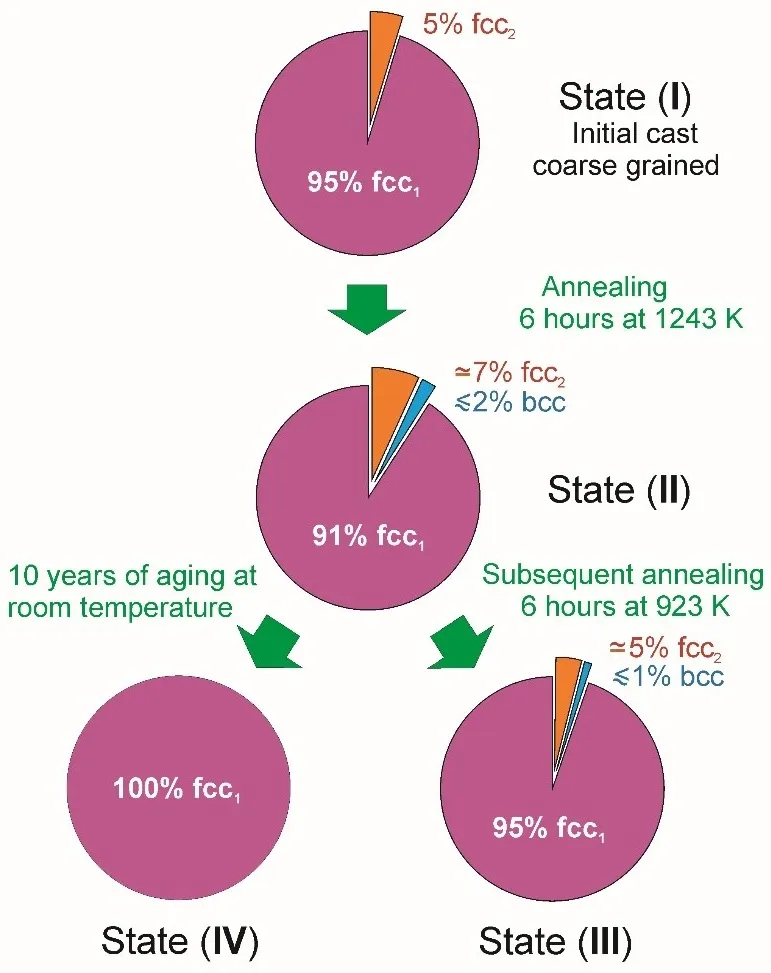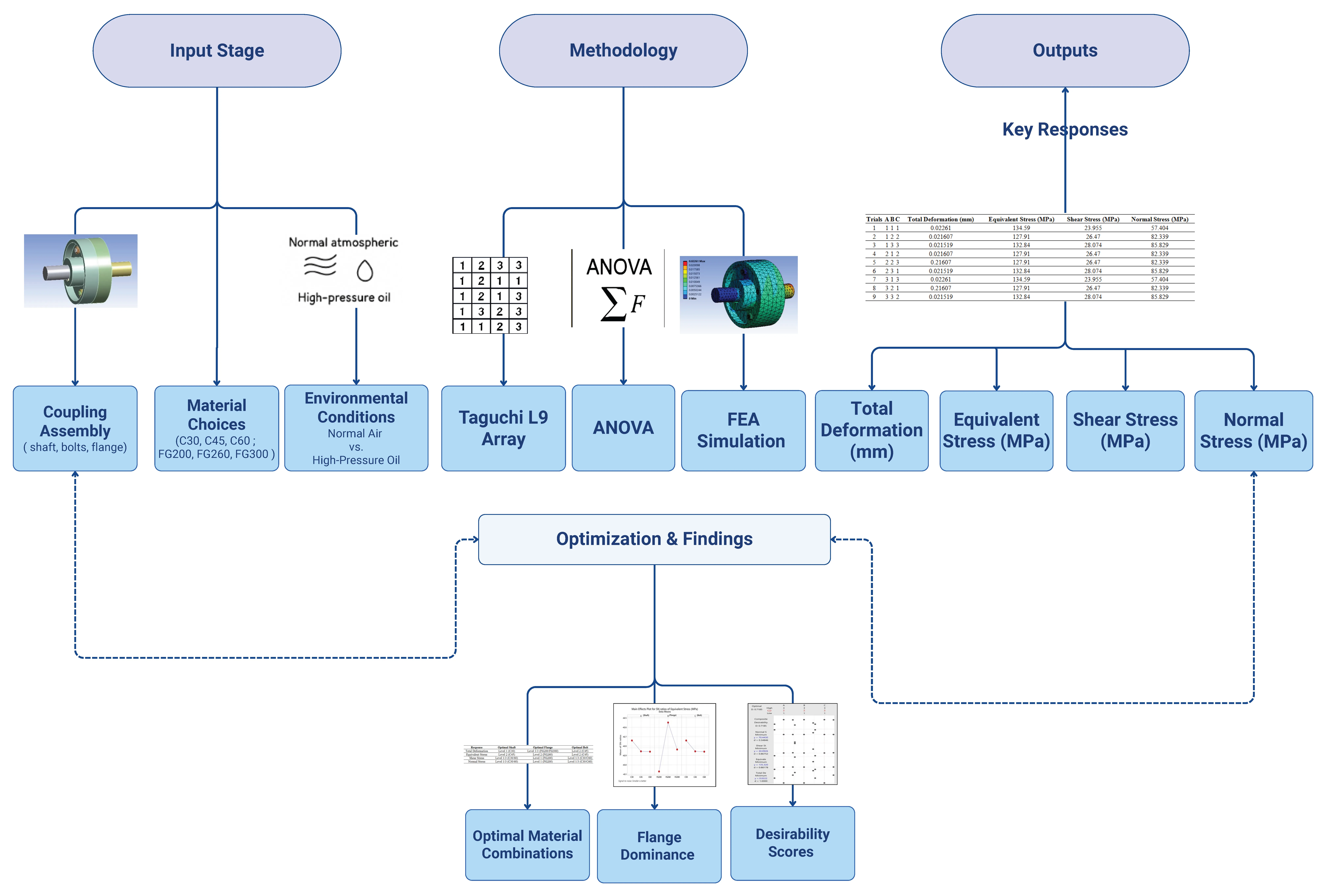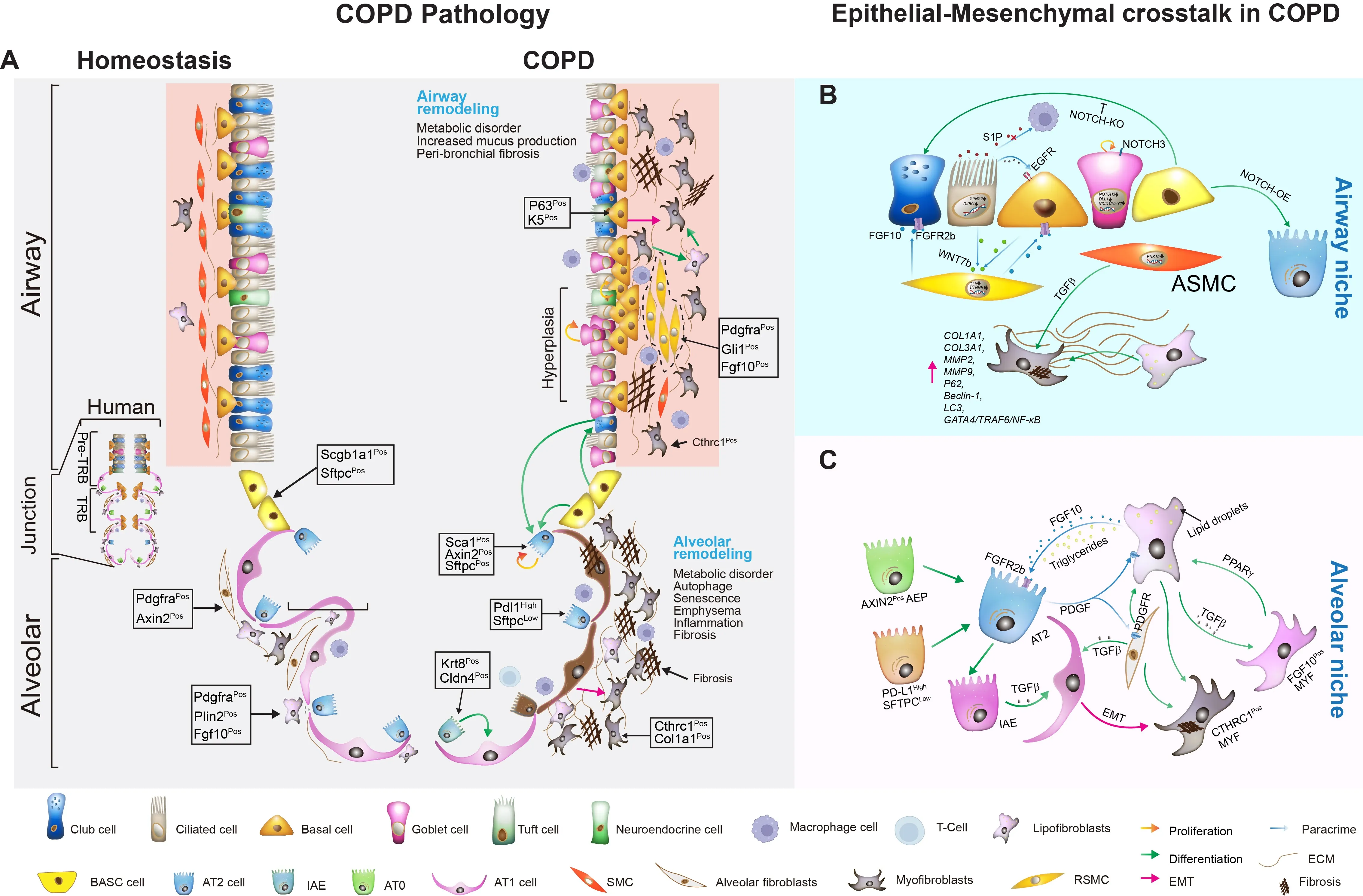Artiles
Open Access
Article
11 September 2025Investigation of Structure of the High-Entropy Alloy Al0.5CoCrCuFeNi
A detailed examination of the structure of the high-entropy alloy Al0.5CoCrCuFeNi at room temperature was carried out using different methods of optical microscopy, electron microscopy and X-ray structural analysis techniques. Numerical estimates of the dislocation density ∼5⋅1015 m−2, the mean size of the ordered (crystalline) domains ~18 nm and lattice micro strain ∼3⋅10−3 were obtained through Williamson-Hall analysis of XRD patterns. The estimates of the dislocation density were found to correlate with the estimates of the total length of dislocation segments per unit volume, which effectively interact with elastic vibrations of the sample ∼4⋅1013 m−2, as previously determined from acoustic relaxation measurements. This is consistent with the idea that a significant portion of dislocations are concentrated in grain boundaries, and only dislocation segments located inside grains and having a favourable orientation with respect to the direction of sound wave propagation can effectively interact with cyclic deformation of the sample.

Open Access
Article
09 September 2025Multi-Response Optimization of Rigid Flange Coupling Using Taguchi Design, ANOVA, and FEA in Dual Environmental Conditions
This study investigates the mechanical behaviour and optimization of rigid flange couplings operating under two distinct environmental conditions: normal atmospheric air and high-pressure oil surroundings. A Taguchi L9 orthogonal array was employed to evaluate material combinations for the shaft, flange, and bolt based on four mechanical responses: total deformation, equivalent stress, shear stress, and normal stress. Analysis of variance (ANOVA) and regression modelling were used to identify significant parameters, with flange material consistently emerging as the most influential factor. Desirability analysis was conducted to determine the optimal material configurations for each environment. Under atmospheric conditions, the combination of C30 shaft, FG200 flange, and C45 bolt achieved a composite desirability of 0.6667. In high-pressure oil conditions, the optimal configuration was C45 shaft, FG260 flange, and C45 bolt, with a desirability of 0.7185. These optimal settings, not present in the original matrix, were independently validated using finite element analysis (FEA). The comparison between regression predictions and FEA results showed strong agreement, with a maximum percentage error of 6.02%, within acceptable engineering limits. This study confirms that environmental pressure significantly influences coupling performance and that material selection should be tailored accordingly. The integration of statistical optimization and simulation offers a robust framework for designing couplings in pressure-sensitive applications.

Open Access
Review
08 September 2025Epithelial-Mesenchymal Niche Dysfunction in COPD: Emerging Opportunities for Targeting Cellular Plasticity and Crosstalk
Chronic obstructive pulmonary disease (COPD) is a leading cause of global morbidity and mortality, characterized by progressive airway and alveolar remodeling. The disease pathogenesis is commonly driven by chronic environmental insults, leading to airway obstruction, emphysema, and chronic bronchitis. This review synthesizes emerging evidence that altered epithelial cell behavior and dysfunctional epithelial-mesenchymal interactions serve as pivotal drivers of COPD pathogenesis, orchestrating failed repair and structural degeneration. We detail how altered responses of airway (ciliated, club, basal, goblet) and alveolar (AT1 and AT2) epithelial cells lead to cellular senescence, metaplasia, defective regeneration, and barrier disruption, acting as primary instigators of pathogenesis. We also summarize current knowledge on the mechanisms of activation and pathogenic role of mesenchymal cells, which drive peribronchiolar fibrosis, alveolar destruction, and metabolic reprogramming, alongside the compromised reparative function of mesenchymal stem cells (MSCs). We emphasize how distinct mesenchymal niches (e.g., PDGFRαPos MANCs, FGF10Pos lipofibroblasts, SFRP1Pos fibroblasts) and distinct epithelial stem/progenitor subpopulations critically contribute to pathogenesis. Key signaling pathways—including FGF10/FGFR2b, WNT, Hippo, NOTCH, and TGF-β—mediate epithelial-mesenchymal transition (EMT), stem cell niche function, and structural remodeling. By dissecting how epithelial injury responses and mesenchymal niche failure collaboratively drive COPD progression, we identify actionable targets to disrupt pathogenesis and restore endogenous repair. We propose targeting EMT, including inhibiting EMT/fibrosis, promoting alveolar regeneration, MSC-based therapies, exosome-delivered biomolecules, and precision cell transplantation strategies, as promising future therapeutic strategies.

Open Access
Perspective
08 September 2025From Priming to Therapy: Leveraging New Insights in T Cell Activation
CD8 T cells constitute one of the pillars of the adaptive immune response. They play a key role in eliminating pathogen-infected and cancerous cells. To effectively carry out their function, naïve CD8 T cells must undergo priming/activation in which several cell types, receptors, cytokines, and chemokines are involved. Various therapeutic approaches, such as vaccinations and anti-cancer therapies, i.e., immune checkpoint blockade (ICB) and Chimeric Antigen Receptor (CAR) T cell transfer, attempt to harness CD8 T cell biology to protect from or treat life-threatening diseases. Despite the significant success of CD8-T-cell-related therapies, the overall response rate of cancer patients remains relatively low, perhaps due to an incomplete understanding of the crucial events leading to optimal CD8 T cell activation. Recent findings highlight the importance of CD4 T cell help in CD8 T cell priming as well as the existence of an additional priming phase for the selection and expansion of high affinity T cells. Together, these findings offer a refined conceptual framework to guide future research and therapeutic development. Here, we present a revised perspective on clinically relevant CD8 T cell–based therapies in light of recent discoveries.

Open Access
Article
08 September 2025Open Water in Winter: An Influential but Underestimated Ecosystem in Northern Boreal Mountain Regions
Patches of open water (polynyas) persist throughout six-month winters on many ice-covered lakes in boreal mountain ecoregions of northwestern North America. We explored their distribution, hydrological correlates, and the diversity of species using them from freeze-up to break-up. In headwater drainages, lakes with outflow polynyas were significantly larger than those without, but many small lakes also had polynyas. There was a consistent threshold in upstream catchment size below which outflow polynyas were absent and above which they persistently occurred in downstream lakes. Outflow polynyas depend on winter-long through-flow of water, likely maintained by the hydraulic head of higher elevation ground water in perched water tables in this region of very limited permafrost. Based on camera trapping, two species, the American dipper and river otter, used polynyas heavily throughout winter foraging. Polynyas likely provided crucial forage for at least 9 species of migratory waterfowl (Anatidae) to complete their spring migration or to prepare for reproduction on local lakes. Cameras recorded additional 5 bird and 11 mammal species, as foragers, scavengers, or incidentally. We report previously undocumented significance of these spatially-limited and seasonal polynya ecosystems in expanding the diversity of winter ecological opportunity for numerous species on small to medium-sized lakes.

Open Access
Article
08 September 2025Large Language Model for Secure Operation of Power Systems
The integration of large-scale renewable energy, multi-criteria operational constraints, and complex grid topologies has intensified the challenges faced by the security monitoring process within power system dispatch. Dispatch guidelines, typically expressed in natural language, are difficult for conventional algorithms to interpret and apply in real time, while general-purpose Large Language Models (LLMs) lack domain-specific knowledge, risking inaccurate or unsafe recommendations. This study proposes an LLM-based monitoring framework that integrates domain-specific prompt engineering with fuzzy evaluation to address these limitations. The framework interprets dispatch guidelines, analyzes real-time power flow data, and converts semantic assessments into quantitative safety scores, enabling closed-loop decision-making. Validation on the IEEE 14-bus system demonstrates that the optimized LLM outperforms a general LLM in accuracy, logical consistency, and stability under complex multi-standard scenarios, while reducing reliance on manual intervention. The results highlight the framework’s potential to enhance monitoring efficiency and ensure intelligent, secure power system operation.

Open Access
Article
05 September 2025A Green Way for the Synthesis of Ester Oil by an Ionic Liquid as Both a Catalyst and Lubricant Additive
A series of ionic liquids 1-alkyl-3-methylim idazole bis(2-ethylhexyl) phosphate, were prepared, and the catalytic performance of ionic liquids was evaluated through the esterification reaction of pentaerythrotol and hexanoic acid at a stoichiometric ratio as a model reaction. The results showed that the [BMIM][DEHP] and [HMIM][DEHP] exhibited good catalytic activity. The [HMIM][DEHP] was chosen as a lubricant additive to further investigate the tribological properties after the reaction, and the results for both COF and WSD and wear volume indicate that the introduction of [HMIM][DEHP] has improved the friction reducing and anti-wear properties of pentaerythrotol tetra-hexanoate.

Open Access
Review
04 September 2025Collagen Biosynthesis to Engineered Biomaterials: Molecular Design, Synthetic Strategy, and Biomedical Application
Collagen, a principal component of the extracellular matrix, provides mechanical strength and stability to tissues and organs through its structural organization. Its biocompatibility has established it as a crucial material in biomedical applications such as drug delivery systems, cell culture matrices, and tissue engineering scaffolds. However, the use of animal-derived collagen carries risks of pathogen transmission, which has driven research towards developing synthetic collagen alternatives. Advances in AI-assisted protein engineering are accelerating the design of synthetic collagens and their applications in biomaterials. This review examines collagen’s structural characteristics, biosynthesis strategies, biological activities as well as AI-assisting engineering.

Open Access
Review
03 September 2025Defect Engineering in Carbon-Based Metal-Free Catalysts: Active Sites, Reduction Mechanisms, and 3D Architectures for Sustainable 4-Nitrophenol Reduction
Nitrophenols (NPs), classified as priority pollutants due to their significant toxicity, persistence, and bioaccumulation potential, pose severe threats to ecosystems and human health. Catalytic reduction, particularly the conversion of NPs like 4-nitrophenol (4-NP) to less toxic aminophenols using sodium borohydride (NaBH4), represents a promising remediation strategy. While conventional metal-based catalysts face limitations including high cost, poor durability, and potential metal leaching, carbon-based metal-free catalysts (C-MFCs) have emerged as highly efficient, sustainable, and cost-effective alternatives. However, the precise reaction mechanisms governing NP reduction over C-MFCs remain ambiguous, and significant debate surrounds the nature of the active sites and the structure-activity relationships dictating performance. This review systematically elucidates the catalytic sites and associated reduction mechanisms in C-MFCs. We comprehensively summarize design principles centered on defect engineering strategies, encompassing single-atom (N, S, B, P, O), dual-atom (B,N; N,S; N,P), and tri-atom (B,N,F; N,P,F) doping, alongside non-doping defects such as edge and pore defects. The critical structure-performance relationships linking these engineered active sites to catalytic activity (e.g., turnover frequency, TOF) are analyzed, integrating experimental evidence and theoretical insights. Furthermore, strategies for constructing three-dimensional architectures to enhance active site accessibility and catalyst stability are highlighted. This work provides fundamental insights to guide the rational design of next-generation high-performance C-MFCs for sustainable nitrophenol pollution control.

Open Access
Article
03 September 2025From Fossil to Future: Trade, Technology and Clean Energy Transitions in High-Impact Developing Economies
This study examines the impact of economic growth, renewable energy equipment imports, and energy use on CO2 emissions in seven developing countries over the period 2000–2021, employing second-generation panel estimators (Augmented Mean Group AMG, The Common Correlated Effects Mean Group CCEMG) that account for cross-sectional dependence and slope heterogeneity. Results show that economic growth and energy use significantly increase emissions, while renewable energy equipment imports display no direct or robust mitigating effect. This limited impact likely reflects adoption and integration challenges and the absence of complementary policies, underscoring the need for strategies that link imports to technology transfer and domestic manufacturing capacity. Granger causality tests indicate that growth and renewable energy imports drive emissions, highlighting the necessity for integrated green industrial policies, carbon pricing mechanisms, and sustainable finance instruments. These findings suggest that, for developing economies, achieving low-carbon growth requires a coordinated policy mix that aligns environmental objectives with economic development goals.
